- OBLIQUE DISPLAY DESIGN (or FLAG)
- See ‘flag for slanted display’.
![[Pont-à-Celles]](../images/v/vxt-d1307.gif)
Flag of the Army For Slanted Display, Bolivia (fotw & CS)
- OBVERSE
- The face, or more important side, of a flag; and in the Western tradition
always depicted with the hoist to the observer’s left - the dexter in heraldry – see
‘dexter hoist’ (also
'double-sided 1)',
‘mirror image’, and
'two-sided 1)'.
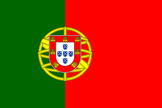

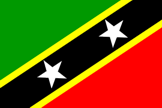
Obverse of the National Flag of Portugal (fotw);
Obverse of the National Flag of The Maldives (fotw);
Obverse of the National Flag of St Kitts and Nevis (fotw);
Please note however, that in Arabic tradition the
flag is generally depicted with the hoist to the observer’s right – the sinister
in heraldry (see also ‘sinister’;
‘dexter’,
‘reverse’ and
‘sinister hoist’).
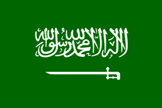
National Flag of Saudi Arabia (fotw)
- OCCASIONAL FLAG
- See ‘commemorative flag’.

Centennial Flag 1905-2005 Alberta, Canada (fotw)
- OCILA
- See ‘firesteel’.
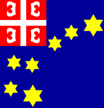
Flag of Zvezdara, Serbia (fotw)
- OFF-CENTRED
- A term used to describe the vertical or horizontal arm of a cross that is
not set on a flag’s vertical or horizontal meridian – see ‘off-centred cross 2)’ below
(also ‘centred’
and ‘off-set towards’).
- OFF-CENTRED CROSS
- 1) Generically see ‘Scandinavian Cross’.
- 2) Specifically, a cross of the Scandinavian-type that is used on a flag
which is not from, or has no connection with that region – a horizontal Latin or Scandinavian-type cross.
- 3) A cross whose vertical
arm may or may not be centred but whose
horizontal arm is closer to the top or bottom of the flag – but see note below.


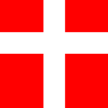
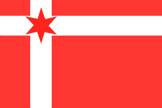
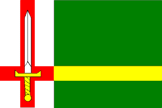
From left: Hong Kong Christians (fotw);
Volyinia, Ukraine (fotw);
Thunstetten, Switzerland (fotw));
Flag of Vídeň, Czech Republic (fotw); Flag of
Zdechovice; Czech Republic (fotw)
Please note with regard to 3) that in heraldic terms an off-centred cross
whose vertical arm is centred but whose horizontal arm is closer to the top of
a flag may be blazoned a Latin cross throughout, or if closer to the bottom of the flag a Latin cross throughout reversed – see
‘Latin Cross’ in
‘Appendix VIII:’ (also ‘reversed 2)’
and ‘throughout’).
- OFF-SET (or OFFSET) TOWARDS
- The term used to describe a charge (or charges) or a stripe (or stripes) that is (or are) set
towards the hoist, fly, top or base of a flag, rather than lying on its vertical or horizontal meridian
– shifted towards (see also ‘centred’,
(see also ‘charge’,
‘inset’,
‘meridian’, ‘off-centred’ and
‘optical proportions’).
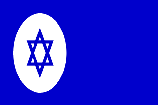
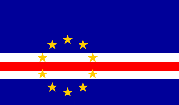
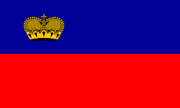

Civil Ensign of Israel (fotw); National Flag of the
Cape Verde Islands (fotw); National Flag of
Liechtenstein (fotw); National Flag of
Rwanda (fotw)
Please note that this term should always be accompanied by a further description,
for example, off-set towards the hoist.
- OFFICER’S BROAD PENNANT (or PENDANT)
- See broad pennant 3) and ‘officer's pennants’.
![[yacht commodore]](../images/v/vxt-d1246.gif)
Yacht Club Commodore’s Broad Pennant, Finland (fotw)
- OFFICER’S FLAGS
- In US usage and in some others, those flags that are flown by the past and present
officers of a club, especially of a yacht or boating club – yacht officers flags
(but see ‘broad pennant 3)’ and ‘officer's pennants’).
![[yacht commodore]](../images/v/vxt-d574.gif)
![[yacht vice commodore]](../images/v/vxt-d574a.gif)
![[yacht rear commodore]](../images/v/vxt-d574b.gif)
![[acht past commodore]](../images/v/vxt-d574c.gif)
Typical examples from left:
Yacht Commodore, US (fotw);
Yacht Vice Commodore,
US (fotw); Yacht Rear Commodore, US (fotw);
Yacht Past Commodore, US (fotw)
- OFFICER’S PENNANTS (or PENDANTS)
- The term that may be used to describe those pennants (often - but not exclusively - a
swallow-tailed version of the relevant club burgee or flag) flown by the past or present
officers of a club, especially of a yacht or boating club – a flag officer, yacht officer
or officer’s broad pennant or a yacht officer’s pennant – but see
‘officer's flags’ and
‘broad pennant 3)’ (also
‘burgee’ and
‘swallow-tail(ed)’).
![[officer's pennant]](../images/v/vxt-d166a.gif)
![[officer's pennant]](../images/v/vxt-d166b.gif)
![[officer's pennant]](../images/v/vxt-d166c.gif)
![[officer's pennant]](../images/v/vxt-d166d.gif)
![[officer's pennant]](../images/v/vxt-d166e.gif)
Yacht Commodore, Naval Club of Brasilia (fotw); Yacht Commodore and Vice-Commodore,
National Yacht Club, Ireland (fotw); Yacht Commodore and Vice-commodore, Nieuwpoort YC, Belgium (fotw)
- OFFICIAL FLAG
- 1) A flag that has been formally adopted by the relevant authority, and/or is considered by them to
represent a particular entity, institution or cause, as opposed to a design or type which is not so authorized
- see ‘unofficial flag’ (also ‘de jure’, ‘flag law’,
‘institutional flags (official)’, and
‘type flag’).
- 2) A term that may be employed to describe a sub-national flag which is specifically for official rather
then general civil use, and usually distinguished by the addition of arms (see also ‘banner 4)‘,
‘civil flag’,
‘ceremonial flag 1)’,
‘state service flag’ and
‘sub-national flag’ with following notes).
![[Hapoel Tel-Aviv official flag]](../images/v/vxt-d2357.gif)
![[Hapoel Tel-Aviv unofficial flag]](../images/v/vxt-d2358.gif)
![[Słubice official flag]](../images/v/vxt-d1768a.gif)
![[Słubice civic flag]](../images/v/vxt-d1768b.gif)
Official and Unofficial Flag of the Hapoel Tel-Aviv Football Club, Israel (fotw);
Official Flag and Civic Flag of Słubice , Poland (fotw)
- OGIVAL
- The term for a form of flag (now obsolete), or of a gonfanon, where the
fly is rounded and comes to a point – boat-tailed or shield-shaped – but see
‘lanceolate’ (also
‘engrailed fly’,
gonfalon 1),
‘Gothic shield’
and ‘shield’).

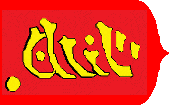
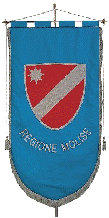
Flag of Persia c1350? (fotw); Flag of Grenada, Spain c1350 (Klaus-Michael Schneider); Gonfanon of Molise, Italy (official website)
Please note that the differences between “ogival” and “lanceolate” are
often very slight, and we suggest that both entries be consulted.
- OLD GLORY
- 1) Generally a poetic nickname for the US national flag – the Stars and Stripes (see
also ‘Betsy Ross flag’,
‘continental colours’,
‘eagle standard’,
‘Franklin flag’,
‘great star flags’,
‘quincunx’,
‘star-spangled banner’ and
‘stars and stripes’).
- 2) Specifically referring to a US national flag bearing 34 stars and a small white anchor,
reputedly belonging to a Captain William Driver.
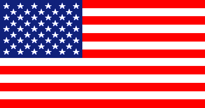
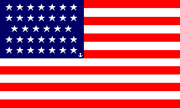
National Flag of the United States (fotw); Captain Driver’s Flag (fotw)
- ONE-AND-A-HALF ARMED CROSS
- The term used in Eastern European heraldry – and a direct translation of the Polish Póltora krzyz – that
describes a Latin cross which has a second horizontal arm projecting on one side only - usually the sinister
(see also ‘cross 2)’,
‘cross of Lorraine’,
‘Latin cross’ in ‘appendix VIII’ and
‘two-and-a-half armed cross’).

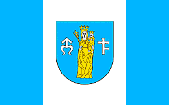

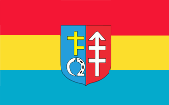

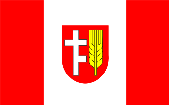
Arms and Flag of Nowy Targ, Poland (fotw); Arms and Flag of Siemiatycze. Poland (fotw);
Arms and Flag of Kobylin-Borzymy, Poland (fotw)
- ONOMAST
- See ‘name pennant’.

Onomast/Name Pennant of the Schooner Walter Holly, New Brunswick c1890 (fotw)
- OPEN
- In some (particularly South European) heraldic usage, a term used when the field can see seen through the door and/or windows of a fortified building – but see ‘ajouré’ (also ‘field 2)’.



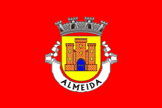
Arms and Flag of Alcácer do Sal, Portugal (fotw);
Arms and Flag of Almeida, Portugal (fotw)
- OPEN CROWN
- See ‘coronet’.

Arms of Real (Castelo de Paiva), Portugal (Sérgio Horta)
- OPEN LOZENGE
- See ‘voided lozenge’.

Flag of
Daillens, Switzerland (fotw)
- OPEN SLEEVE
- A technical term for the normal sleeve of a flag that is open at both ends to receive a staff or
hoistline - see ‘sleeve 2)’ (also
‘closed sleeve’,
‘heading’ and
‘hoisting’).
- OPTICAL PROPORTIONS
- A term used when the relative dimensions of a series of stripes progressively
widen between the hoist and the fly in order to appear even when the flag is flying
- graduated stripes -or where a charge is set slightly towards the hoist so that it appears to be centred
under the same circumstances – two examples would be the national flag of France for
use at sea, and the federal service flag of Germany (see also
‘charge 1)’,
‘hoist’,
‘fly’,
‘off-set towards’,
‘proportions 2)’,
‘stripe’ and
‘visual centre’).
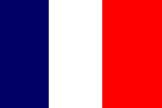

National Ensign of France (fotw); Federal Service Flag of
Germany (fotw)















![[yacht commodore]](../images/v/vxt-d1246.gif)
![[yacht commodore]](../images/v/vxt-d574.gif)
![[yacht vice commodore]](../images/v/vxt-d574a.gif)
![[yacht rear commodore]](../images/v/vxt-d574b.gif)
![[acht past commodore]](../images/v/vxt-d574c.gif)
![[officer's pennant]](../images/v/vxt-d166a.gif)
![[officer's pennant]](../images/v/vxt-d166b.gif)
![[officer's pennant]](../images/v/vxt-d166c.gif)
![[officer's pennant]](../images/v/vxt-d166d.gif)
![[officer's pennant]](../images/v/vxt-d166e.gif)
![[Hapoel Tel-Aviv official flag]](../images/v/vxt-d2357.gif)
![[Hapoel Tel-Aviv unofficial flag]](../images/v/vxt-d2358.gif)
![[Słubice official flag]](../images/v/vxt-d1768a.gif)
![[Słubice civic flag]](../images/v/vxt-d1768b.gif)




















![[Pont-à-Celles]](../images/v/vxt-d1307.gif)
